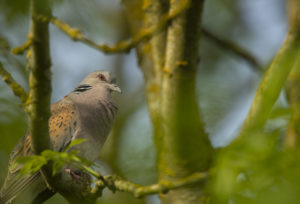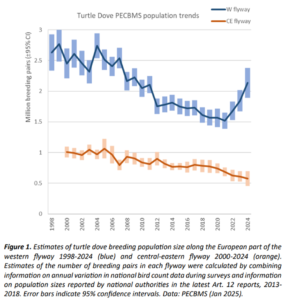Rick Bayne, Senior Project Manager for Operation Turtle Dove, reflects on good news for the species.
It’s that time of year again when anticipation builds around the imminent return of migrant bird species that use the UK to breed and raise their young. Whilst Chiffchaffs already seem to be everywhere and there are widespread reports of other early migrants such as Wheatears and Sand Martins, we will have to wait a little bit longer for the return of Turtle Doves which typically don’t arrive until mid-April.

Here at Operation Turtle Dove, there is always some nervousness ahead of their arrival. The birds have of course undertaken two huge journeys to and from their wintering grounds in sub-Saharan Africa since we last saw them. When and where will the first UK sighting be? Will they be returning to their old haunts? And perhaps most importantly, how many will there be?
As I write this in late March, a returning Turtle Dove has already made landfall at Waterford, southern Ireland, so perhaps we shouldn’t be too worried. Furthermore, there is some additional good news regarding the wider western European breeding population which might get all of us with an interest in the recovery of Turtle Doves just a little bit excited!
New figures just released show the number of these special birds breeding in Western Europe as a whole increased by 40% from 2021 to 2024… that’s an additional 615,000 breeding pairs gained since 2021! For a bird that suffered a 99% decline in its UK breeding population between 1967 and 2020, this gives real hope that things are on the right track to see a turn-around in their fortunes.
The graph below is taken directly from the recent report presenting the new population figures, and shows trends from both the Western European Flyway breeding population, where a hunting moratorium has been in place, and the separate Central and Eastern European Flyway breeding population, where no such level of hunting management is yet in place.

So, what has brought about this turn of fortune? Prior to 2019, around one million Turtle Doves were being hunted each autumn in total across the three Western European counties where they are legal quarry: Spain, Portugal and France. This level of hunting was shown to be clearly unsustainable, further compounding the long-understood impacts of a shortage of good quality breeding habitat. Resulting international conservation action led to a hunting management system called “adaptive harvest management” being put in place for Turtle Doves in Western Europe. This determined that a hunting moratorium was required as a first stage, and this was subsequently established across France, Spain and Portugal in 2021. Assessed annually, this adaptive harvest management system has been developed to ensure that any future hunting of Turtle Doves is genuinely sustainable for the whole flyway population and conducted at a level that will allow continued long-term recovery.
Compared to the recent past, this is a much-improved outlook for Turtle Dove conservation all across Western Europe, including the UK. Co-ordinated international action and the co-operation of European hunting organisations has been followed by a rapid increase in the Turtle Dove population at the flyway scale. And with an adaptive harvest management system grounded in science in place, we can be confident that the population will continue to recover.
What does it mean for the future of Turtle Doves here? With the UK’s location at the northern edge of the Western European flyway breeding population range, there is likely to be a time-lag before more birds are seen here. Recovery is likely to be first seen in the core of the population, Spain and then France, before it spreads to the edges. However, recovery of the population core is almost certainly required to drive future recovery at the edges. Therefore, the encouraging figures released give us growing confidence that with continued recovery at flyway population scale, and we can also expect to see more Turtle Doves reaching these shores over the next few years.
So, the priority here and now is to make sure we deliver on the other requirement and continue working to ensure there is plentiful breeding and feeding habitat waiting for them on their arrival each spring. Last year, Operation Turtle Dove worked with more farmers and land managers than ever before to do this. If you haven’t already, look at our advice pages and get in touch with one of our Turtle Dove Conservation Advisers. Let’s get the UK ‘Turtle Dove Ready’!
Read the Full Technical Update announcing the population increase.








